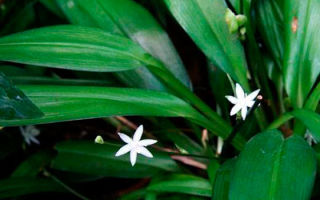Content
- 1 What does chlorophytum look like?
- 2 The chemical composition of chlorophytum
- 3 The benefits of chlorophytum for home and health
- 4 Chlorophytum in folk medicine
- 5 Is chlorophytum harmful?
- 6 Is chlorophytum dangerous for cats?
- 7 Signs and superstitions associated with chlorophytum
- 8 How to care for chlorophytum
- 9 Conclusion
- 10 Reviews
Chlorophytum is an unpretentious house plant. It can survive in any conditions: it does not need constant and abundant watering, it grows in pots of any size and does not depend on sunlight. With extreme care, chlorophytum will not dry out, but can only fade, lose color. Many housewives choose this plant for its ease of care and beautiful, lush appearance. This article discusses the benefits and harms of chlorophytum, the rules for caring for it, and interesting facts.
What does chlorophytum look like?
The homeland of the plant is South Africa. It grows on the roots of trees as an epiphyte, that is, it does not take any nutrients from the host plant, but uses the bark as its own "place of residence." In Europe, chlorophytum appeared in the 20th century and became popular due to its ease of care and reproduction, as well as many beneficial properties for human health. Of the 200 species for the house, chlorophytum varieties are chosen that are beneficial to humans and do not harm:
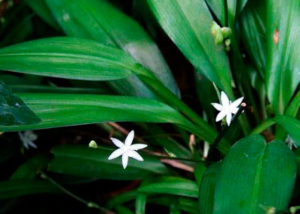
- Chlorophytum Crested... This species grows for 10 - 13 years. It has narrow light green leaves 40-50 cm long. Each has a distinctive pale yellow stripe in the middle. The bush grows up to 60 cm in diameter. In early spring, shoots 2 - 5 cm in diameter begin to appear (children). Small white chlorophytum flowers form on them, they are invisible in most photos. The useful properties of crested chlorophytum are its ability to actively fill the room with oxygen and cleanse it of toxic substances.
- Chlorophytum Curly... The view does not reach lush size and is suitable for a small room. The leaves are dark, and the strip in the middle is almost white. They are shorter in length, but rather dense in structure. The main feature of this variety is the ability of the leaves to curl into bizarre shapes and create a "curl" effect.
- Chlorophytum Cape... The leaves of the variety are wide, dark green in color, there is no light strip in the middle. The ends are pointed. The Cape does not reach large sizes, it is hung on special pots or kept on a flat surface.

The chemical composition of chlorophytum
The plant contains a number of beneficial nutrients:
- Essential oils... Their bactericidal and antiseptic properties are used in folk medicine. Essential oil neutralizes inflammation when applied topically and reduces stress levels;
- Anthraquinone... This chemical has the beneficial effect of improving intestinal peristalsis and has a laxative effect. Anthraquinone helps with the liver and stomach.
- Cascaroside... One of the sources of vitamin A, like celandine, aloe, rhubarb. Cascarosides from chlorophytum are used medicinally to improve the metabolic properties of the body.
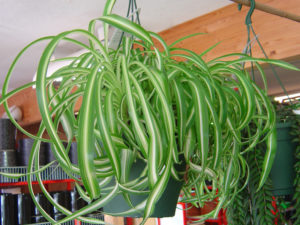
The benefits of chlorophytum for home and health
Chlorophytum is a conspicuous, vibrant plant that catches the eye. In addition to its pleasant external qualities, chlorophytum has benefits for the home environment and human health.These include:
- air purification and humidification;
- accumulation of toxins and chemicals;
- the fight against negative energy;
- destruction of bacteria.
Cleans the air
Chloroplasts (biological plastids, due to which the process of photosynthesis occurs) accumulate in the leaves. Thanks to them, the plant belongs to one of the active air purifiers. It is capable of absorbing up to 80% of harmful carbon dioxide emissions at home. It is placed in the kitchen, where the concentration of harmful gases is higher than normal.
Humidifies the air
Chlorophytum tends to accumulate moisture. Largely because of this, the plant survives in the arid conditions of South Africa. Massive roots collect water, so he lives without watering for 1 - 2 weeks. In a dry environment, the plant begins to give off moisture and thereby moisturizes the apartment.
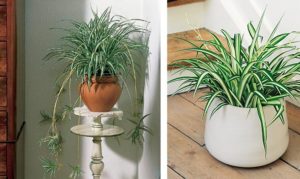
Absorbs harmful chemicals
In living quarters, toxic substances accumulate that harm the human body. These are emissions of synthetic fabrics, paint on walls and ceilings, benzene, ammonia and other gases. Chlorophytum has the ability to absorb all these harmful substances and then use them for its own growth and development. The more toxic gases the plant absorbs, the faster it grows and the more lush the foliage becomes.
Fights negative energy
Chlorophytum is popular among followers of the feng shui traditions. It is believed that this plant is able to regulate positive and negative energies. At home, it helps to improve close relations between relatives, and at work, it reduces stressful conditions and improves the emotional state of a person. Experts advise active workaholics to buy this plant at home so that it helps to strengthen relationships with loved ones. Chlorophytum is beneficial for children by calming them down and helping them to become diligent for successful studies.
Destroys disease-causing bacteria
Chlorophytum is a useful sanitary plant that copes with the elimination of bacteria and weak viruses. Interestingly, there are practically no cases of infection of the plant itself. It is resistant to most plant diseases, therefore it has a cleansing function.
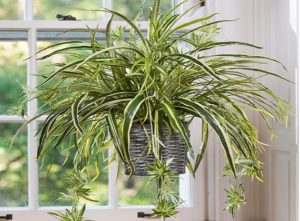
Chlorophytum in folk medicine
The healing properties of chlorophytum are used to further aid in getting rid of diseases. Due to its beneficial bactericidal properties, the plant, when ground and processed, is used to heal light wounds and injuries. Special tinctures are used to treat diseases of the respiratory system - asthma, bronchitis, pneumonia, tuberculosis - due to the plant's ability to absorb toxic substances that are harmful.
Is chlorophytum harmful?
The plant benefits the mental health of a person by creating positive energy in the house, physical - by purifying the air from harmful components. Damage to the plant is possible only in case of accidental ingestion of small children into the mouth. The leaves have a rough, rough surface that can damage thin mucous membranes and lead to unpleasant consequences. Therefore, it is important to place the plant pot out of the reach of children. In other cases, we can talk about the benefits of this flower.

Is chlorophytum dangerous for cats?
It is believed that he is a flower that can be harmful to pets. This is not true.Cats eat the leaves to artificially induce a gag reflex to get rid of the hairballs that clog the stomach. You can wean an animal from eating a plant by planting a special "cat grass". These include valerian, mint, catnip. Cats eat it to normalize digestion and cleanse the stomach and intestines of hair.

Signs and superstitions associated with chlorophytum
Belief in the magical properties of chlorophytum speaks of the observed properties of the plant to help people in different areas of life.
Famous superstitions about the benefits of the chlorophytum flower read:
- It is recommended to enter a new house with chlorophytum in order to create a positive atmosphere and fill the place with coziness. It will be easier to take root in a new environment with this indoor plant.
- It is believed that the plant withers and loses its useful properties in the house, where they constantly quarrel and swear, a negative atmosphere and negative energy reign. It serves as an indicator and suggests when relationships with household members become aggravated and the time has come to try to improve them.
- Chlorophytum is called "bride's veil" for the similarity of flowers to wedding decorations. It is acquired by single people to find love and family happiness. The plant will help in strengthening existing relationships, make them stronger and more trusting.
- A good omen is considered to be the sprouting of the flower. If there are more than 20 - 30 of them, it means that the person will be successful: his material condition will improve, and bright joyful moments will appear in his life.
How to care for chlorophytum
Indoor chlorophytum is undemanding to care, it will benefit even with minimal efforts of the owner, however, it is worth monitoring the growing conditions so as not to harm foliage discoloration and other unpleasant consequences.

- Reproduction... Getting a new bush is possible by separation during transplantation or by separating the shoots from an adult plant. In this case of reproduction, a large plant is obtained. Another option is to plant the rosette in moist soil: over time, the shoots will give their own roots and young shoots. Flowers will appear on them, from which a whole bush will develop. Chlorophytum propagates by seeds, but this method is inconvenient at home.
- Watering... Chlorophytum loves moisture. Watering should be increased in summer and reduced in winter. Waterlogging or extreme drying should not be allowed, because under such conditions the plant will wither and darken. The bush should be regularly sprayed with plain water from a spray bottle. Dust accumulates on wide sheets, so they need to be wiped with a damp cloth or towel so as not to block the oxygen passage and not to inhibit the process of photosynthesis.
- Lighting... The flower is not capricious to light. It grows in both dark and light parts of the room. In very bright sunlight, the bush becomes excessively lush, and in muted (except for dark) conditions, it absorbs moisture better. In the summer, the plant can be taken out onto the balcony.
- Transfer... Chlorophytum quickly develops a root system, so once a year the plant is advised to be transplanted into a larger pot or divided into several bushes. The roots are cut with a sharp knife. The soil must be well moistened before planting in a new pot.
- Fertilizers... The flower does not need special fertilizers. In the spring and summer, you can feed it with any complex supplements.
Conclusion
Summing up the benefits and harms of chlorophytum, we can say with confidence that this is a universal plant that has important beneficial properties and has no contraindications. The flower is unpretentious, easy to grow and care for, suitable for beginner growers and indoor plant lovers.

